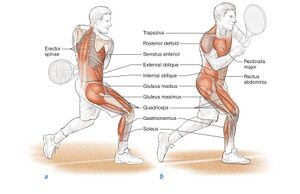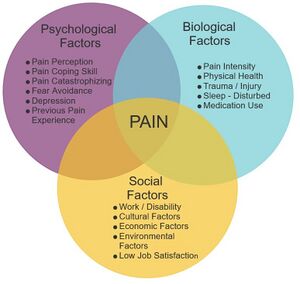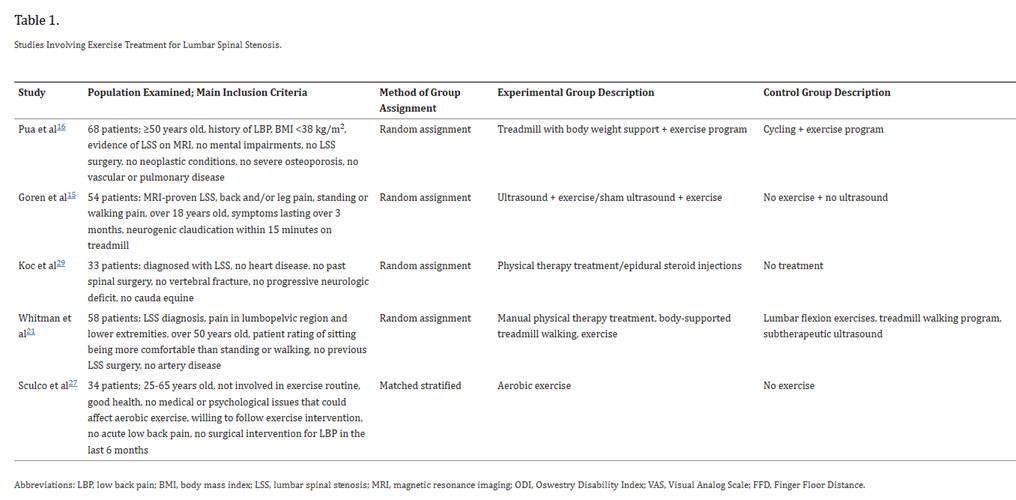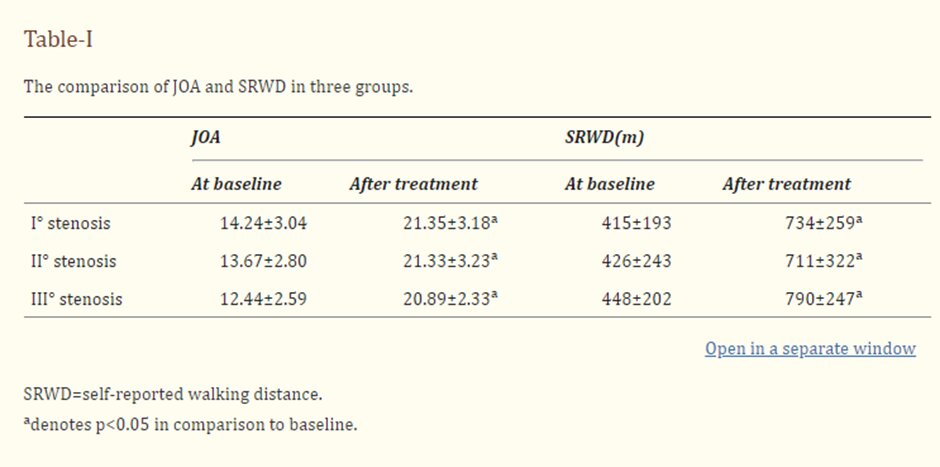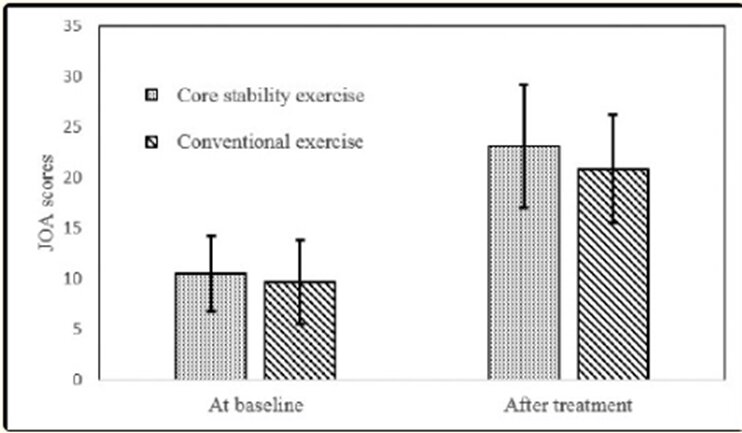Core stabilisation exercises vs decompression surgery for lumbar spinal stenosis
1. Lumbar stenosis/Introduction- Link to Physiopedia page on Lumbar stenosis[edit | edit source]
Role: Malachi
- Definition
- Severities
- Affects on patients and health service
- Symptoms
- Epidemiology/Aetiology
- Diagnosis
- Relationship to LBP and reduced ADLS?
2. Current practice[edit | edit source]
Role:Toby
- Guidelines
- Gold standard
- Indications for surgery
Core stabilisation exercise[edit | edit source]
When talking about core stability, this is referencing multiple groups of muscles that surrounding the lumbo-pelvic-hip complex. These muscles play a vital role in everyday life by: (Kibler, Press and Sciascia, 2006)
- Allowing bodies to remain stable by controlling the position and motion of the trunk over the pelvis
- Offload excessive loads from the spine
- Allows for the control of force transfer and motion along the kinetic chain
- Prevent injury
Main inner core muscles:
- Pelvic floor
- Transversus abdominis
- Internal abdominals obliques
- Multifidus
Main outer core muscles:
- Rectus abdominus
- External obliques
- Quadratus lumborum
- Glutes
These above muscles produce high torque to counterbalance external forces impacting the spine; thus, this group of muscles is secondarily responsible for maintaining spinal stability, aiding in improving function and reducing pain (Chang, Lin and Lai, 2015)
What's the aim?[edit | edit source]
When treating patients with stenosis it’s important to keep in mind exercises does not directly alter the stenotic changes, but has a positive effect on pain relief, muscle power, motor skill and improved daily activity (Goren et al., 2010). This positive affect can be down to many aspects of exercise, but the primary belief is that exercises not only aid in muscle power, flexibility and neural control but also has a clinically significant impact on psychosocial barriers such as anger, fear or confusion which prevent activities of daily living for patients with spinal stenosis (Sculco et al., 2001)
Do core exercises improve outcomes in stenosis?[edit | edit source]
A SR review by (Slater et al., 2015) looks into perceived influence of exercise on pain and disability in patients with lumbar stenosis. This study includes 5 of 310 RCTS including 238 patients with lumbar stenosis and similar demographics. Methodological quality of all studies was assessed with PEDro averaging 6.2/10 with a range of 2-8 with only 1 study not having blinded subjects.
The 3 studies included that focused on core stability exercises are as follows:
| Study and groups | Primary outcome pre | Primary outcome post | Outcome for core ex |
| Goren et al (2010)
· Core exercises (CE) /w ultrasound · CE /w sham ultrasound |
Oswestry disability index:
Sham ultrasound: 26.9 |
Oswestry disability index:
6/52
Sham ultrasound: 19.1 |
↓ Pain vas
↓ODI Disability score |
| Pua et al (2007)
· CE + treadmill · CE + cycling |
Oswestry disability index:
Treadmill group: 33.0 Cycling group: 31.8 |
Oswestry disability index:
3/52
Cycling group: 23.0 |
↓ Pain vas
↓ODI Disability score |
| Koc et al (1976)
· CE · Lumbar epidural injections (LEI) |
Pain VAS out of 100:
Core exs: 54.1 LEI: 56.3 Control: 58.6 |
Pain VAS out of 100:
3/12
LEI: 20.5 Control: 27.7 |
↓Pain VAS
↑Physical mobility ↑Amount of sleep ↓Fatigue
|
What can be concluded from the overall study is that core exercises offer a low-cost effective intervention for patients with stenosis who present with pain and reduced disability.
Does stenosis severity impact the effectiveness of core exercise?[edit | edit source]
This question is explored by Chen et al., 2017, looking if core exercise effectiveness correlates with the severity of spinal stenosis.
This study included:
- 42 participants
- 3 groups - varying degree of spinal stenosis
- daily core stability exercises over 6 weeks
Outcomes:
- Japanese Orthopaedic association score (JAO)
- Self-reported walking capacity.
The outcome of the results of this study were able to confirm that the severity of stenosis diameter does not have any correlation to the effectiveness of core exercises when looking at disability and walking distance improvements. Understanding this allows us to vastly increase the scope of appropriate patients. It is however important to note that the severity of stenosis was determined by physiological factors alone without inclusion of psychosocial elements. Further study would be required to include severity of this demographic to further increase ecological validity of the trial.
What core stability exercises are used?[edit | edit source]
It is unfortunately common for studies to not publish in depth information of the exact exercise programmes they utilise in their studies. Due to this lack of information, there is no one consensus about which are the best set of exercises to use for patients with lumbar stenosis. Mu et al., 2018 published what exercises he used when comparing core exercises to conventional exercise in stenotic patients in an RCT containing 33 participants. Mu found that plank, side plank, bridge, and modified push-up all found to provide higher functional than the conventional group.
See https://www.physio-pedia.com/Core_Stability and https://www.physio-pedia.com/Core_Strengthening for a list of viable exercises and prescription methods.
4. Lumbar decompression[edit | edit source]
Role:Anita
- Define
- Theory
- Criteria
- Costs
- Risks
- Evidence
5. Conclusion[edit | edit source]
Role: Jack
- SR's looking at short and long term outcomes of core ex vs stenotic decomp
- Develop conclusion on core stability ex vs surgical decomp
- Bring together what has been said overall
References[edit | edit source]
Chang, W.-D., Lin, H.-Y. and Lai, P.-T. (2015). Core strength training for patients with chronic low back pain. Journal of Physical Therapy Science, [online] 27(3), pp.619–622. doi:https://doi.org/10.1589/jpts.27.619.
Goren, A., Yildiz, N., Topuz, O., Findikoglu, G. and Ardic, F. (2010). Efficacy of exercise and ultrasound in patients with lumbar spinal stenosis: a prospective randomized controlled trial. Clinical Rehabilitation, [online] 24(7), pp.623–631. doi:https://doi.org/10.1177/0269215510367539.
Kibler, W.B., Press, J. and Sciascia, A. (2006). The Role of Core Stability in Athletic Function. Sports Medicine, [online] 36(3), pp.189–198. doi:https://doi.org/10.2165/00007256-200636030-00001.
Mu, W., Shang, Y., Mo, Z. and Tang, S. (2018). Comparison of two types of exercises in the treatment of lumbar spinal stenosis. Pakistan Journal of Medical Sciences, [online] 34(4). doi:https://doi.org/10.12669/pjms.344.15296.
Sculco, A.D., Paup, D.C., Fernhall, B. and Sculco, M.J. (2001). Effects of aerobic exercise on low back pain patients in treatment. The Spine Journal, [online] 1(2), pp.95–101. doi:https://doi.org/10.1016/s1529-9430(01)00026-2.
Slater, J., Kolber, M.J., Schellhase, K.C., Patel, C.K., Rothschild, C.E., Liu, X. and Hanney, W.J. (2015). The Influence of Exercise on Perceived Pain and Disability in Patients With Lumbar Spinal Stenosis. American Journal of Lifestyle Medicine, [online] 10(2), pp.136–147. doi:https://doi.org/10.1177/1559827615571510.
